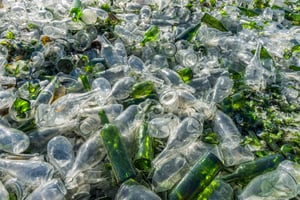Waste materials are bad news for local Councils, but they represent an opportunity for beneficial re-use.
Developing fit-for-purpose recycled granular material blends represents a significant opportunity for Local Government Authorities to not only deal with poor quality marginal materials, but also to help counteract waste stockpiles.
Often marginal materials or certain recycled materials such as crushed concrete can suffer from grading deficiencies or poor plasticity index (PI).
ARRB recently undertook a project for Canterbury-Bankstown City Council (CBCC) in Sydney, NSW to help implement the use of higher amounts of recycled crushed glass (RCG) in their road rehabilitation and capital works program.
CBCC had a source of crushed concrete which was designated as a dense graded base (DGB) material. However, this material had a very low PI and a coarse grading.
This presented the ARRB team with the opportunity to blend the material with RCG to improve PI and adjust the grading of the material to allow improved field compaction and hence provide increased permanent deformation resistance. This work was undertaken in three stages.
The first stage was a laboratory assessment of the materials performance to optimise the blend of crushed concrete with RCG. This involved characterisation of the base materials.
The crushed concrete material was treated as a control to assess permanent deformation under ARRB’s dedicated extra-large wheel-tracker (XL-WT) to understand baseline performance. Blends of crushed concrete and RCG were then put through the same process to determine the optimum blend. A blend of 70% crushed concrete and 30% RCG was selected for scale-up with a view to use on CBCC’s road network.
The second stage of the work looked at the feasibility of scale-up in partnership with Fulton Hogan.
The crushed concrete and RCG materials were put through an asphalt batching plant to blend and homogenise them. A compaction trial of the blended materials using full-scale construction equipment was undertaken in the Fulton Hogan yard to check the required field densities could be achieved.
The third stage of the project involved laying a field trial of the blended material in a road rehabilitation on the CBCC network.
This work was undertaken on Marion Street near Bankstown Aerodrome. The material was used as a granular subbase of 200 mm thickness. The section paved was approximately 270m long and consisted of about 330 tonnes of material.
The ARRB team were present to observe the construction in mid-February 2022. After construction was complete performance of the trial section was assessed visually and with a falling weight deflectometer (FWD). A sample of the blend used in the field trial section was taken back to the ARRB laboratory for testing in the XL-WT to confirm conformance.
This project is an excellent case study to demonstrate the beneficial use of recycled materials to adjust poor quality materials to improve performance.
For more information on the beneficial use of recycled materials in transport infrastructure, please contact us at https://www.arrb.com.au/contact-us
Major trial with Victorian Council on recycled crushed glass
